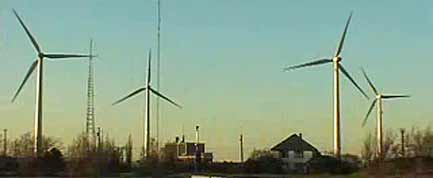Powerful Ideas: Reducing China's Carbon Emissions a Breeze

China is now the world's largest producer of carbon dioxide, the most important global warming pollutant. However, new findings suggest wind farms could potentially eliminate much if not all of China's carbon dioxide emissions from the power sector for the foreseeable future.
Demand for electricity in China is increasing at a rate of about 10 percent per year. At the same time, coal accounts for roughly 80 percent of total electricity production. This suggests that China's emissions of carbon dioxide could grow accordingly.
For example, the equivalent of 800 gigawatts of coal-fired power plants are needed to meet the rising Chinese demand for electricity anticipated by 2030. This could add as much as 3.5 billion tons of carbon dioxide emissions per year, compared to current annual Chinese emissions of 6.6 billion tons.
Wind is currently only a minor contributor to China's energy needs, with an installed capacity of 12.2 gigawatts at the end of 2008, or just 0.4 percent of its total electricity supply. However, China is now the world's fastest growing market for wind power, with an annual growth rate of more than 50 percent over the past decade.
"The world is struggling with the question of how do you make the switch from carbon-rich fuels to something carbon-free," said researcher Michael McElroy at Harvard University. "The real question for the globe is — what alternatives does China have?"
To see how much energy wind farms could generate for China, scientists at Harvard University and Tsinghua University analyzed wind data from a state-of-the-art NASA global weather and climate model that incorporated measurements worldwide from surface observations, aircraft, balloons, ships, buoys and satellites. They also looked at the Chinese government's energy bidding practices and financial restrictions to figure out regional costs for delivering wind power.
They found that onshore wind farms could profitably generate enough power to accommodate all of China's electricity demand projected for 2030, about twice its current consumption. The researchers assumed the wind energy would be produced from a set of land-based 1.5-megawatt turbines operating over non-forested, ice-free, rural areas with a slope no more than 20 percent. They also accounted for the fact that turbines often operate at as little as a fifth of their rated capacity in China, due to a combination of factors, such as lower quality of Chinese turbines, limitations of the power grid, and less-than-optimal placement of turbines to take advantage of wind resources.
Sign up for the Live Science daily newsletter now
Get the world’s most fascinating discoveries delivered straight to your inbox.
"Wind farms would only need to take up land areas of 0.5 million square kilometers, or regions about three quarters of the size of Texas," said researcher Xi Lu at Harvard University. "The physical footprints of wind turbines would be even smaller, allowing the areas to remain agricultural."
A switch to wind power could prove invaluable to curbing any impact China would have on global climate, the researchers noted — as much as 1.1 billion tons of carbon dioxide could be saved per year if just 30 percent of the additional electricity China required by 2030 were produced from wind rather than coal.
"China is bringing on several coal fire power plants a week," McElroy said. "By publicizing the opportunity for a different way to go we will hope to have a positive influence."
This switch to wind power would demand a major financial investment up-front and require careful long-range planning on China's part. Still, the benefits for the Chinese economy could be substantial, as the value of damages linked with air pollution is estimated at up to $167.7 billion, or 4.3 percent of the nation's roughly $3.9 trillion gross domestic product.
"China has become a leader in the wind power industry, not just because of issues surrounding environmental protection and climate change mitigation, but potentially because of all the potential jobs it could create, the potential economic benefits it might have if China becomes a leader," said renewable energy industry researcher Joanna Lewis at Georgetown University, who did not participate in this study. "There are security benefits as well that they're thinking seriously and strategically about, from relying on renewable sources of energy and not requiring imports."
"This study really illustrates how wind can be an important part of China's climate change mitigation strategies, how it can play a much larger role in China than today," Lewis added. "But realistically, it can't be the only part, because it won't be feasible to replace all of coal power with wind power in the time scale we would need to address climate change."
In the coming months, the scientists plan to conduct a more intensive wind study in China, taking advantage of 25-year data with significantly more detailed information for north Asian regions to investigate the geographical year-to-year variations of wind. The model used for analyzing China could also be applied for assessing wind potential anywhere in the world, onshore and offshore, and could be extended to solar generated electricity, they noted.
They are also investigating how wind can be integrated into the power grid in Texas, for example, Lu told LiveScience.
Lewis added that more research needed to be done "on why wind farms have been producing less power than they should in China, and how the power structure currently supporting wind power can be modified to make sure it gets developed properly. If you're building all these farms, you want to get as much from them as you can."
McElroy, Lu and their colleagues detailed their findings in the Sept. 11 issue of the journal Science.
- Video: How Wind Power Works
- Video: The History of Wind Power
- More Poweful Ideas











